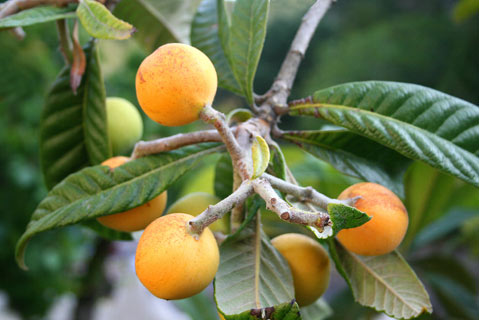Loquat Trees
Fruiting and Ornamental, Provide a Handsome Garden Backdrop

Loquat trees can provide shade or a handsome backdrop to the rest of the garden. There are two common species of Eriobotrya grown in landscapes, and both have large, heavily veined evergreen leaves. One is handsome and tidy; the other is handsome and, well, a little messy now and then. Both are useful and desirable, but for different reasons.
E. deflexa, the bronze loquat tree (because of the bronzy hue on the underside of its leaves), makes a neat (and tidy) subject. It grows to 25 feet or so and spreads about as wide. The large, glossy leaves are nearly 10 inches long and 3 inches wide. As an evergreen, the leaves drop a few at a time all year long, but that’s only half of the tidy part. It has bunches of small cream-colored flowers that are only mildly and briefly showy, soon disappearing altogether. A rather more striking feature is that the new growth, usually in early spring, is as lovely as the red-bronze first growth on rose bushes (to which they are related). Imagine that all over a tree!
The other widely grown species, Eriobotrya japonica, goes one step further in its utility by producing juicy, sweet fruits. This is the bonus but also the mildly messy part. Most edible loquat trees produce a large crop nearly every year — usually more than most gardeners welcome within the confines of the garden. That’s why they are successfully relegated to the background, where they can feed the birds and bees after their human caretakers have had their fill. The fruit may vary widely, from mildly insipid to rivaling mangoes and perfectly ripened apricots. These juicy fruits are delicious and healthful, but contain several large seeds, making the harvest seemingly more work than it is worth.
There are some improved varieties that produce larger fruit, increasing the fruit-to-seed ratio, so look for them. Some of the more common ones are ‘Champagne’ and ‘Gold Nugget,’ which have been selected for flavor but are still on the small side. Another one that combines larger fruits and the best flavor is ‘MacBeth’. There are a couple of methods to improve fruit size and reduce fruit overload. Keeping the foliage thinned out a bit to allow more light in and thinning the small, unripe orbs are reported to be successful. As a background plant, a loquat tree can provide a brilliant way to include food into the more designed landscape. If that’s too much to take on, the bronze loquat will fill the bill with less maintenance required.
February Tips
• Check your irrigation system (it may already be back on auto from that last dry spell). Make sure fittings are not leaking and spray heads and bubblers have not become clogged with mineral deposits.
• Prune fuchsias mid-month for early and prolific bloom.
• Check mulch levels, and renew to a depth of four to six inches.
• Plant greens for a quick harvest: Arugula, beet greens, leaf lettuces, spinach, and cress are all ready to start picking in just 20-45 days.



